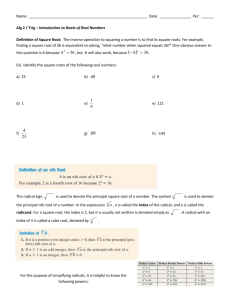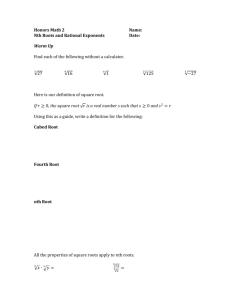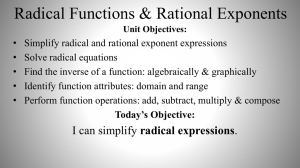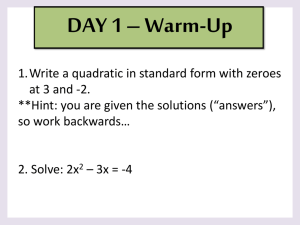Math 1010 - Lecture 23 Notes Dylan Zwick Fall 2009
advertisement
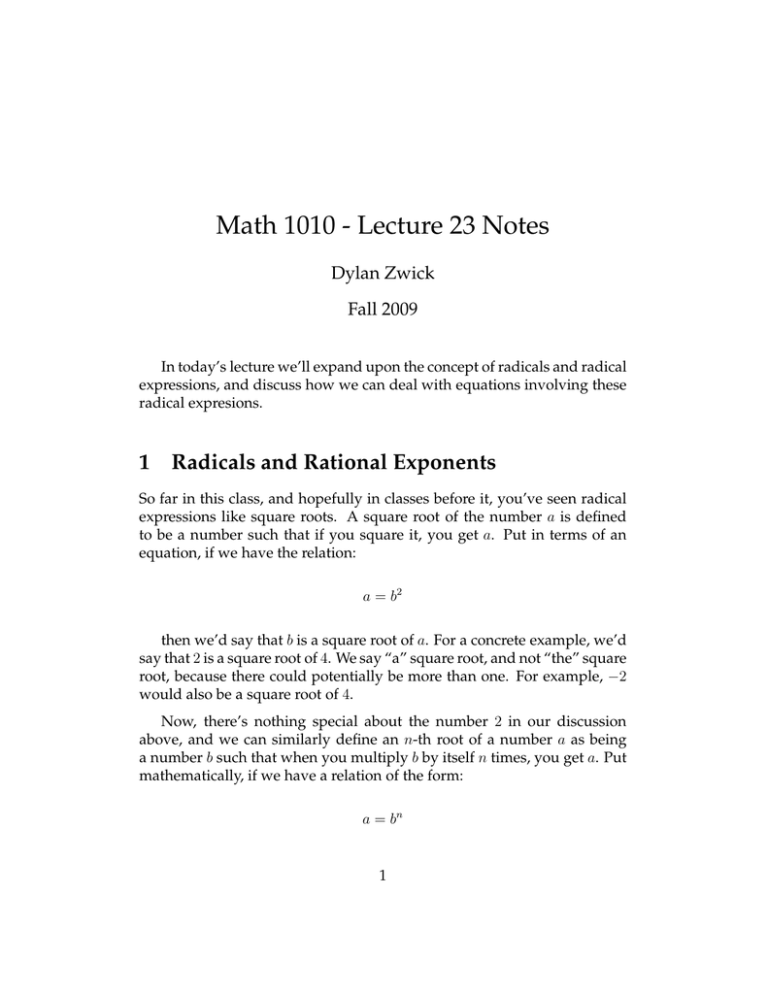
Math 1010 - Lecture 23 Notes Dylan Zwick Fall 2009 In today’s lecture we’ll expand upon the concept of radicals and radical expressions, and discuss how we can deal with equations involving these radical expresions. 1 Radicals and Rational Exponents So far in this class, and hopefully in classes before it, you’ve seen radical expressions like square roots. A square root of the number a is defined to be a number such that if you square it, you get a. Put in terms of an equation, if we have the relation: a = b2 then we’d say that b is a square root of a. For a concrete example, we’d say that 2 is a square root of 4. We say “a” square root, and not “the” square root, because there could potentially be more than one. For example, −2 would also be a square root of 4. Now, there’s nothing special about the number 2 in our discussion above, and we can similarly define an n-th root of a number a as being a number b such that when you multiply b by itself n times, you get a. Put mathematically, if we have a relation of the form: a = bn 1 we say that b is an n-th root of a. So, for example, we’d say that 2 is a 3rd root of 8, also called a cube root, and that 3 is a 4th root of 81. Now, if we have a real number a, we call the nth root of a that is a real number with the same sign as a the principal nth root of a, and we denote it as: √ n a. So, for example, while there are two 4th roots of 16, namely 2 and -2, there is only one principal 4th root, namely 2. In general, the number of roots will depend upon whether n is even or odd:1 • If n is even and a > 0 then √ nth roots, given by √ there will be two (real) the principal nth root n a and its opposite − n a. √ • If n is odd there will be one (real) nth root, the principal nth root n a. • If n is even and a < 0 there will not be any (real) nth roots. Also note that if a = 0 there is only one nth root, namely 0 itself. Examples. 1. √ 3 27 1 We haven’t introduced complex numbers yet, but in fact for any complex number that isn’t zero, there will be exactly n roots. However, in most cases most of these roots will be complex numbers themselves, and we’re only concerned with real numbers for now. If that didn’t make sense to you, don’t worry about it. 2 2. √ 3 3. √ 4 −27 −81 Now, exponents aren’t just restricted to natural numbers. We can have rational exponents too. For example: 43/2 = √ √ 43 = ( 4)3 = 8. b In general if we’ve got a rational exponents, so a c , then this is equal to: b ac = √ c √ ab = ( c a)b . Note that it doesn’t matter if we take the root first and then exponentiate, or if we exponentiate first and then take the root. In either case, we get the same result. Note that all of our rules for exponents apply, without modification, if we expand our possible exponents to include rational numbers.2 Examples. Calculate the following. 2 We can also make sense of exponents that involve irrational numbers, like 2π , for example. However, we won’t worry about those here. 3 1. p (−10)2 . 3 2. 81− 4 . 2 Simplifying Radical Expressions How we simplify radical expressions begins with the product and quotient rules for radicals. √ √ uv = n u n v r √ n u u n • = √ , v 6= 0. n v v • √ n Using these rules, the first thing we want to do when simplifying a radical expression with an nth root is remove perfect nth power factors √ from the radical. For example, if we have 75 we can note that 75 = 3 × 25 and that 25 is a perfect square factor. So, we can simplify our radical by rewriting it as: √ 75 = √ √ √ 25 3 = 5 3. A radical expression is said to be in simplest form if all three of the statements below are true. 1. All possible nth powered factors have been removed from each nth radical. 4 2. No radical contains a fraction. 3. No denominator of a fraction contains a radical. Examples Simplify the following terms. 1. √ 96. 2. r 13 . 25 3. r 35 . 64 3 12 4. √ . 3 5 √ 3 9 5. √ . 3 25 3 Functions Involving Radicals So far, we’ve just dealt with radical expressions involving constants. We can expand our range by introducing variables. A radical function is a function that contains a radical such as f (x) = √ x or g(x) = √ 3 x. √ Now, the domain of a radical function f (x) = n x, where n is an integer greater than 1, is determined by whether n is even or odd. • If n is odd, the domain of f (x) = √ n x is the set of all real numbers. √ • If n is even, the domain of f (x) = n x is the set of all nonnegative real numbers. √ So, for example, √ the domain of x is all nonnegative real numbers, while the domain of 3 x is all real numbers. Now, we can simplify radicals with variables using the same methods we used when simplifying radicals with just numbers. So, for example: √ √ x2 = |x| while √ x3 = x x. 6 √ Note that we cannot just write x2 = x unless you happen √to know that x is nonnegative. If we don’t know this, we have to write x2 = |x|. We √ know in the second one that x is nonnegative, because the domain of x3 is all nonnegative real numbers. Examples Simplify the following expressions. 1. √ 56x2 √ . 8 2. p 4 324y 6. 3. p 3 16x4 y 5 . 4. r 3u2 . 16v 8 4 7
